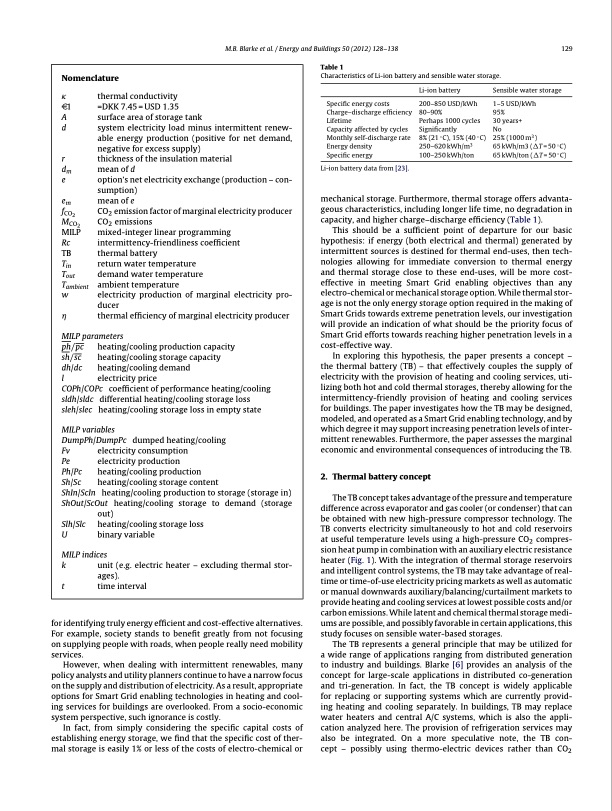
PDF Publication Title:
Text from PDF Page: 002
M.B. Blarke et al. / Energy and Buildings 50 (2012) 128–138 129 Table 1 Characteristics of Li-ion battery and sensible water storage. Nomenclature thermal conductivity D1 =DKK 7.45 = USD 1.35 A surface area of storage tank d system electricity load minus intermittent renew- able energy production (positive for net demand, negative for excess supply) r thickness of the insulation material dm mean of d e option’s net electricity exchange (production – con- sumption) em mean of e fCO2 CO2 emission factor of marginal electricity producer MCO2 CO2 emissions MILP mixed-integer linear programming Rc intermittency-friendliness coefficient TB thermal battery Tin return water temperature Tout demand water temperature Tambient ambient temperature w electricity production of marginal electricity pro- ducer thermal efficiency of marginal electricity producer MILP parameters ph/pc heating/cooling production capacity sh/sc heating/cooling storage capacity dh/dc heating/cooling demand l electricity price COPh/COPc coefficient of performance heating/cooling sldh/sldc differential heating/cooling storage loss sleh/slec heating/cooling storage loss in empty state MILP variables DumpPh/DumpPc dumped heating/cooling Fv electricity consumption Pe electricity production Ph/Pc heating/cooling production Sh/Sc heating/cooling storage content ShIn/ScIn heating/cooling production to storage (storage in) ShOut/ScOut heating/cooling storage to demand (storage out) Slh/Slc heating/cooling storage loss U binary variable MILP indices k unit (e.g. electric heater – excluding thermal stor- ages). t time interval Specific energy costs Charge–discharge efficiency Lifetime Capacity affected by cycles Monthly self-discharge rate Energy density Specific energy Li-ion battery data from [23]. Li-ion battery 200–850 USD/kWh 80–90% Perhaps 1000 cycles Significantly 8% (21 ◦C), 15% (40 ◦C) 250–620 kWh/m3 100–250 kWh/ton Sensible water storage 1–5 USD/kWh 95% 30 years+ No 25% (1000 m3 ) 65kWh/m3(T=50◦C) 65kWh/ton(T=50◦C) for identifying truly energy efficient and cost-effective alternatives. For example, society stands to benefit greatly from not focusing on supplying people with roads, when people really need mobility services. However, when dealing with intermittent renewables, many policy analysts and utility planners continue to have a narrow focus on the supply and distribution of electricity. As a result, appropriate options for Smart Grid enabling technologies in heating and cool- ing services for buildings are overlooked. From a socio-economic system perspective, such ignorance is costly. In fact, from simply considering the specific capital costs of establishing energy storage, we find that the specific cost of ther- mal storage is easily 1% or less of the costs of electro-chemical or mechanical storage. Furthermore, thermal storage offers advanta- geous characteristics, including longer life time, no degradation in capacity, and higher charge–discharge efficiency (Table 1). This should be a sufficient point of departure for our basic hypothesis: if energy (both electrical and thermal) generated by intermittent sources is destined for thermal end-uses, then tech- nologies allowing for immediate conversion to thermal energy and thermal storage close to these end-uses, will be more cost- effective in meeting Smart Grid enabling objectives than any electro-chemical or mechanical storage option. While thermal stor- age is not the only energy storage option required in the making of Smart Grids towards extreme penetration levels, our investigation will provide an indication of what should be the priority focus of Smart Grid efforts towards reaching higher penetration levels in a cost-effective way. In exploring this hypothesis, the paper presents a concept – the thermal battery (TB) – that effectively couples the supply of electricity with the provision of heating and cooling services, uti- lizing both hot and cold thermal storages, thereby allowing for the intermittency-friendly provision of heating and cooling services for buildings. The paper investigates how the TB may be designed, modeled, and operated as a Smart Grid enabling technology, and by which degree it may support increasing penetration levels of inter- mittent renewables. Furthermore, the paper assesses the marginal economic and environmental consequences of introducing the TB. 2. Thermalbatteryconcept The TB concept takes advantage of the pressure and temperature difference across evaporator and gas cooler (or condenser) that can be obtained with new high-pressure compressor technology. The TB converts electricity simultaneously to hot and cold reservoirs at useful temperature levels using a high-pressure CO2 compres- sion heat pump in combination with an auxiliary electric resistance heater (Fig. 1). With the integration of thermal storage reservoirs and intelligent control systems, the TB may take advantage of real- time or time-of-use electricity pricing markets as well as automatic or manual downwards auxiliary/balancing/curtailment markets to provide heating and cooling services at lowest possible costs and/or carbon emissions. While latent and chemical thermal storage medi- ums are possible, and possibly favorable in certain applications, this study focuses on sensible water-based storages. The TB represents a general principle that may be utilized for a wide range of applications ranging from distributed generation to industry and buildings. Blarke [6] provides an analysis of the concept for large-scale applications in distributed co-generation and tri-generation. In fact, the TB concept is widely applicable for replacing or supporting systems which are currently provid- ing heating and cooling separately. In buildings, TB may replace water heaters and central A/C systems, which is also the appli- cation analyzed here. The provision of refrigeration services may also be integrated. On a more speculative note, the TB con- cept – possibly using thermo-electric devices rather than CO2PDF Image | Thermal battery with CO2 compression heat pump

PDF Search Title:
Thermal battery with CO2 compression heat pumpOriginal File Name Searched:
Thermal-battery-with-CO2-compression-heat pump.pdfDIY PDF Search: Google It | Yahoo | Bing
CO2 Organic Rankine Cycle Experimenter Platform The supercritical CO2 phase change system is both a heat pump and organic rankine cycle which can be used for those purposes and as a supercritical extractor for advanced subcritical and supercritical extraction technology. Uses include producing nanoparticles, precious metal CO2 extraction, lithium battery recycling, and other applications... More Info
Heat Pumps CO2 ORC Heat Pump System Platform More Info
| CONTACT TEL: 608-238-6001 Email: greg@infinityturbine.com | RSS | AMP |